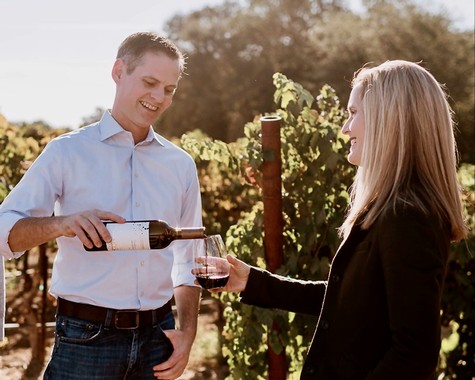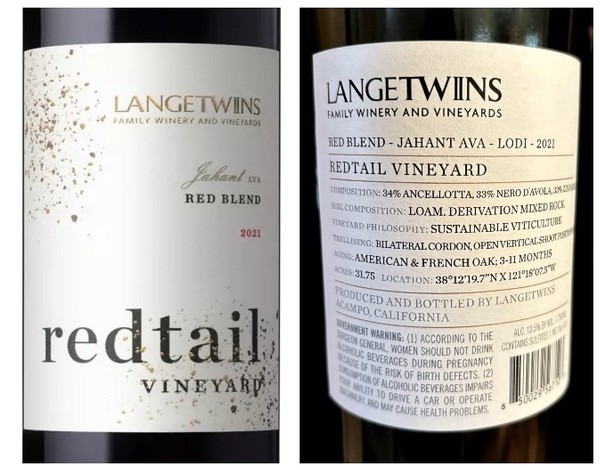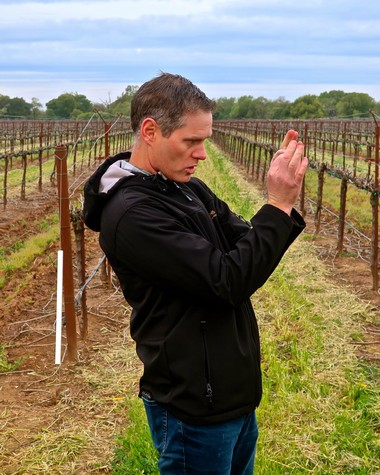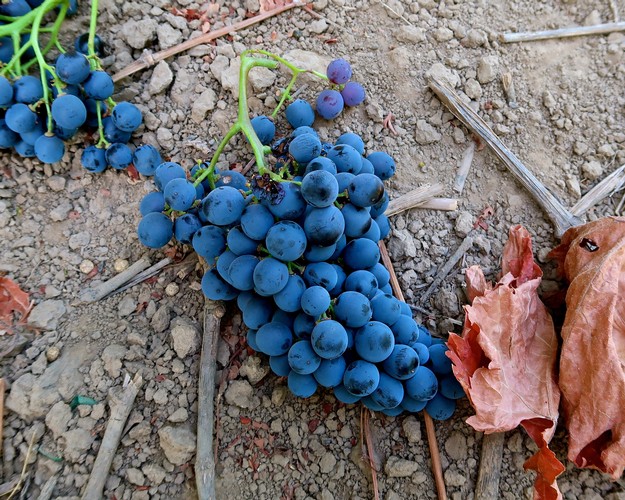Letters from Lodi
An insightful and objective look at viticulture and winemaking from the Lodi
Appellation and the growers and vintners behind these crafts. Told from the
perspective of multi-award winning wine journalist, Randy Caparoso.
LangeTwins Family's newly released Redtail Vineyard is based upon an exciting, potentially groundbreaking grape called Ancellotta

Ancellotta, a native Italian grape grown in LangeTwins Family's Redtail Vineyard, Jahant-Lodi AVA.
LangeTwins Family Winery and Vineyards has done it again. This industry leading family winery and winegrower has just released a red wine joining their Single Vineyard portfolio of sustainably farmed, estate grown wines. It is a sensational blend of Nero d'Avola (33%), Zinfandel (33%), and a grape called Ancellotta (34%).
Zinfandel, everyone knows. Nero d'Avola is a Southern Italian grape finding increasing favor among a growing number of vintners up and down the state, and many American consumers are already fans of Nero d'Avola bottlings imported from Sicily.
But Ancellotta? This is a black-skinned grape that is practically unknown, even among professionals working in the trade (including the most studious sommeliers), media and production industries. Even if you happen to be a wine geek who has read about the grape in texts or books, in all likelihood you still have no idea of how it looks or the way it grows in a vineyard, much less what kind of wine it produces.

Aaron and Marissa Lange of LangeTwins Family Winery & Vineyards.
Ancellotta is a native Italian variety, grown primarily in the Emilia-Romagna region. The 0.3 acres of this grape planted in the Lange Family's Redtail Vineyard⏤located just north of Jahant Rd., adjacent to the LangeTwins Family winery in the Jahant-Lodi appellation⏤represents a California first.
Therefore, you can go ahead and chalk this up as one more example of how Lodi is leading the California wine industry in "forgotten" or alternative wine grapes (see our recent report on the Latest update on the 100+ grapes grown in Lodi).
You should also start practicing the pronunciation of Ancellotta (say ahn-chay-LOT-tah) because it is now going into a genuinely compelling and delicious red wine. The winery's very first vintage, the 2021 LangeTwins Family Redtail Vineyard Jahant-Lodi Red Blend ($38), is beautifully spiced, floral (violet-like), dry, sturdy and zesty, with a vivid purplish ruby color belying its even-keeled, medium bodied character. This sounds like a lot of other red wines, but it really isn't.

Font and highly detailed back label of the 2021 LangeTwins Redtail Vineyard, listing Nero d'Avola, Zinfandel as well as Ancellotta as the blend's three components.
We happened to experience our first taste of this Ancellotta-based red with Tonya Pitts, a visiting sommelier/journalist who is also widely regarded as a super-taster. She appeared to be just as surprised by how bright, upbeat yet seamlessly balanced this unusual blend turned out to be.
In her usual articulate fashion, Ms. Pitts shared these observations: "The wine has a little bit of blueberry, but it's the skin of the blueberry, not the meat. It's not sweet, yet it's very intense in its fruit profile. There is some black tea, plus a distinct pepper jam quality. That is, a spiciness that is similar to jam mixed with chili pepper, the type of pepper jam you can easily find in several guises on the market."
Logic tells you that this unexpected blend's red pepper profile is the result of the interaction between Zinfandel and Ancellotta. Zinfandel is well known for its intrinsic black pepper character, but never a red chile component. In all likelihood, it's the Ancellotta that contributes the unique spice of this particular blend.

Visiting sommelier/super-taster Tonya Pitts.
The wine's third component, Nero d'Avola, is not considered a "spice" varietal, although it almost always produces a dark colored red with plenty of aroma, tannin, and flavor. Nero d'Avola, however, can also be a little monochromatic and, often enough, more than a little earthy. Combined with Zinfandel and Ancellotta in the Redtail Vineyard blend, the Nero d'Avola's intrinsic ferocity comes across as considerably tamed, almost "civilized," sleek rather than rugged, silky rather than rough.
The distinctively spiced profile of the LangeTwins Family Redtail Vineyard blend also strongly suggests meat dishes employing judicious doses of chile pepper, as you often find in Mexican, Cajun, or even Thai cuisine. The Redtail Vineyard blend, in other words, just adds to our list of red wines we might love to sip with foods we love to eat most!
The ongoing LangeTwins Family legacy
Full credit goes to LangeTwins Family's vineyard manager Aaron Lange for bringing in the grape, after learning about it from a colleague in South America. Mr. Lange has been excited about the potential of this grape from the get-go.

LangeTwins Family's Aaron Lange.
He describes Ancellotta as having "the darkest juice I have ever seen in a non-teinturier grape"⏤"teinturier" being grapes that have an unusually red, rather than clear colored, pigmentation in their pulps (the juice of the vast majority of red wine grapes is white). Mr. Lange had a strong hunch that this could be a very important grape; as much because of its unique attributes as its natural suitability to Lodi's Mediterranean climate.
So why is the first LangeTwins Family release of a wine made from Ancellotta a three-way blend rather than a 100% varietal? Because, as winery president Marissa Lange explains, it couldn't be done. "Fun fact about Ancellotta," says Ms. Lange, "the TTB [i.e., the federal government's Alcohol and Tobacco Tax and Trade Bureau] does not recognize the grape as a varietal approved for labels. Even as of today, the grape is not recognized. It's as if Ancellotta doesn't exist, although we clearly know it exists because it's growing right here in our Redtail Vineyard!

Ancellotta in LangeTwins Family's Redtail Vineyard.
"When we printed the labels for our Redtail Vineyard blend, we basically had to ask for grace, which we got, so we managed to get Ancellotta listed next to Nero d'Avola and Zinfandel on the label. Moving forward, we will need to formally petition the TTB for permission, backed up by information demonstrating the grape's origin in Italy and citing its listing in California nurseries.
"Meanwhile, though, you can say that Aaron has been way ahead of his time, in recognizing the potential of this grape in California!"
Mr. Lange adds, "When we began playing around with the grape to find the ways in which it could be used, it occurred to us that Ancellotta might not work as well as a stand-alone wine than it would as a blender. [Senior LangeTwins Family winemaker] Karen Birmingham came up with the idea of blending it with Zinfandel and Nero d'Avola, both growing alongside the Ancellotta in Redtail Vineyard.
"It's really cool that we could find the right components for this blend all in one vineyard. Ancellotta, Zinfandel and Nero d'Avola happen to work really well together, allowing us to bottle it as a true Single Vineyard wine"⏤and as such, another distinctive Lodi wine expressing a genuine "sense of place."

Dropped Nero d'Avola on the gravelly clay loam soil of the Jahant-Lodi AVA of LangeTwins Family's Redtail Vineyard.